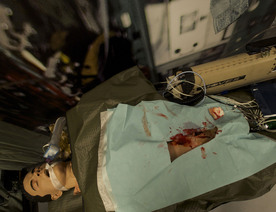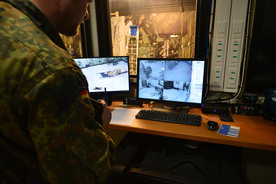NATO Special Ops train to save lives
NATO Special Operations Forces (SOF) medics used advanced combat medical simulators to learn life-saving skills during a five-day course at the SOF Allied Centre for Medical Education (ACME) located at SHAPE, Belgium. The centre is equipped with the most advanced medical simulators and enables personnel to train in realistic combat conditions and provide vital care for the wounded.

On 26 February 2014, a German Army SOF medic attends to a mannequin with a chest wound at the Allied Centre for Medical Education (ACME) training facility. (Photo by U.S. Air Force Staff Sgt Andrew Davis)
A suicide bomber has just blown himself up. There is smoke everywhere. Cries and voices can be heard in the thick fog. Two soldiers have been injured and the suicide bomber is dead. Four SOF personnel secure the perimeter and remove the casualties to a safe place in a hut within a nearby village. The operators examine the injured. One casualty has had both legs blown off. The bleeding must be stopped quickly and the patient evacuated. The other is able to walk, but must be directed to safety. The transport helicopter has been called by radio but will not arrive for another 10 minutes. It will take the casualties to a waiting C-130 plane with a surgical team on board who can provide life-saving damage control surgery.
Despite appearances, this is not a village in Afghanistan or any other war zone. It is the new and extremely realistic SOF medical Centre, opened in October 2013 by NATO Special Operations Headquarters (NSHQ).
The injured soldier, who has lost both legs, is in fact a dummy incorporating the latest trauma simulation innovations with the ability to bleed and interact with the medical care provider. It provides realistic visual and tactile stimuli and a realistic response to the treatment given. The second soldier is a live actor who has been transformed into a combat casualty using mock injuries comprised of the latest bleeding simulation equipment. The environment in which the participants operate is also fictitious: the smoke, the noise of the transport plane, the interior of the C-130 and the desert are all part of the decor.
“What this centre, what this course, and what the larger NATO SOF medicine development initiative does is optimise SOF ability to not only save lives but also to be better utilised by the Alliance,” said Lt Col Dan Irizarry, US Army, Medical Advisor at NSHQ.
The suicide bomber scenario was part of a combat medical simulation course held in February 2014. Eleven students from SOF and conventional medical establishments in seven Allied countries (Belgium, Denmark, Italy, the Netherlands, Norway, Poland and the United States) were divided into two groups to learn how to train and teach their respective combat medical skills using simulators. Some were acting as students in a scenario, while the others acted as instructors, creating, operating and debriefing the scenario to train and enhance combat medical skills.
“The scenario was really realistic, I liked the use of all the rooms going from care under fire to tactical field care to the MEDEVAC,” explained a US student during the debriefing. “The stress in the first room was really good and also the use of a mate with the bleeding limbs,” she continued.
Following the course, SOF graduates will use their new found skills for home station training or bring their SOF medical personnel to the centre to use the full facilities. The graduates will also be able to influence training and priority decisions in their own country. “A recently assigned NSHQ officer is now a senior leader in Czech SOF,” illustrated Lt Col Irizarry. “He sent his medics to our course and some of them are required to train conventional national forces.”
Promoting interoperability

A key component of the NSHQ’s mission is to promote the interoperability of Special Operations Forces, as different nations have varying structural organisations and doctrinal processes. “A key learning objective for every student is to build relationships and understanding between the different SOF elements. That fosters interoperability,” stated Lt Col Kjell Boman, a Swedish SOF physician assigned to the NSHQ medical section.
“The success of this training is really how many different nationalities have come through here and shared their experience and collaborated across nations in the same way that is reality when you meet out in a mission,” said a Danish student.
NATO SOF courses taught at the ACME are not just for SOF. Conventional medical personnel are encouraged to attend so that it is possible to strengthen the understanding and bonds between the larger national medical systems and their smaller SOF medical support systems.
“We are providing a simulation training platform that can be utilised by the Alliance now and in the future to build and maintain SOF medical capability and interoperability connecting these forces for future operations”, added Lt Col Irizarry.
The centre also supports forward operations. The multiple trauma amputation simulators will be deployed this year to support ISAF SOF medic skills testing. “This is an internal research study to help national SOF commanders determine if medics have the necessary skills to meet the requirements of future operations in austere environments outside a 60-minute evacuation window”, he continued.
Finally, nations can request a specific training scenario for their own SOF operators. The Dutch aviation unit has approached the centre to support them in training their conventional flight medics in the C-130 room.
Being at the cutting edge of forward medical care
“The SOF ACME's ability to be flexible, agile, precise and speedy puts it at the cutting edge of far-forward medical care”, explained Lt Col Irizarry. “We are the test bed for new products, techniques and concepts that can be validated by SOF and passed to the larger NATO Alliance. For example, the current tactical combat casualty care guidelines that much of NATO follows today in first responder care were developed by SOF in the late 90s.”
To support this concept, the SOF ACME brings together industry partners, government and non-governmental organisations and academia in a collaborative network that can be leveraged to meet Alliance SOF's and the greater Alliance’s medical needs.
For example, some simulators are procured leveraging the NATO Support Agency (NSPA) expertise, which allowed them to negotiate a NATO price for these simulators and streamlined access for the nations to order these products. “NATO Allies seeking to procure simulators could approach the centre for its expertise and we can provide our best military medical advice to guide their purchase decisions,” Lt Col Irizarry commented. Also, the close relationship with industry partners allows the SOF ACME to influence product improvements and designs that will better meet the Alliance's needs.
Specialised mobile forces

Located at SHAPE in Mons (Belgium), the NATO Special Operations Headquarters is the primary point of development, coordination and direction for all NATO SOF-related activities, in order to optimise employment of Special Operations Forces. In terms of the nationalities of its members, it is one of the most diverse units in NATO.
NATO's Special Operations Forces (SOF) are small, rapidly deployable units that exploit their speed of intervention and the effect of surprise. SOF can act on land, at sea and in the air and can operate independently or in support of conventional forces.
One of the many advantages of SOF is that they can be projected rapidly to respond to emerging crises and be infiltrated into uncertain or politically sensitive environments.
At the 2012 Chicago Summit, the Allies decided to strengthen the SOF's ability to train and operate together. Combat medicine is one area being strengthened.
